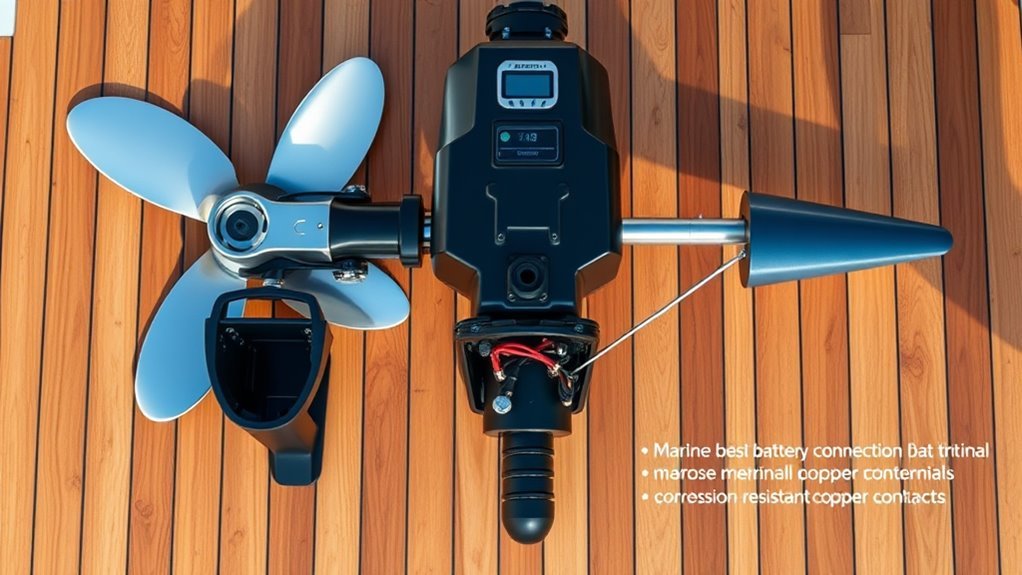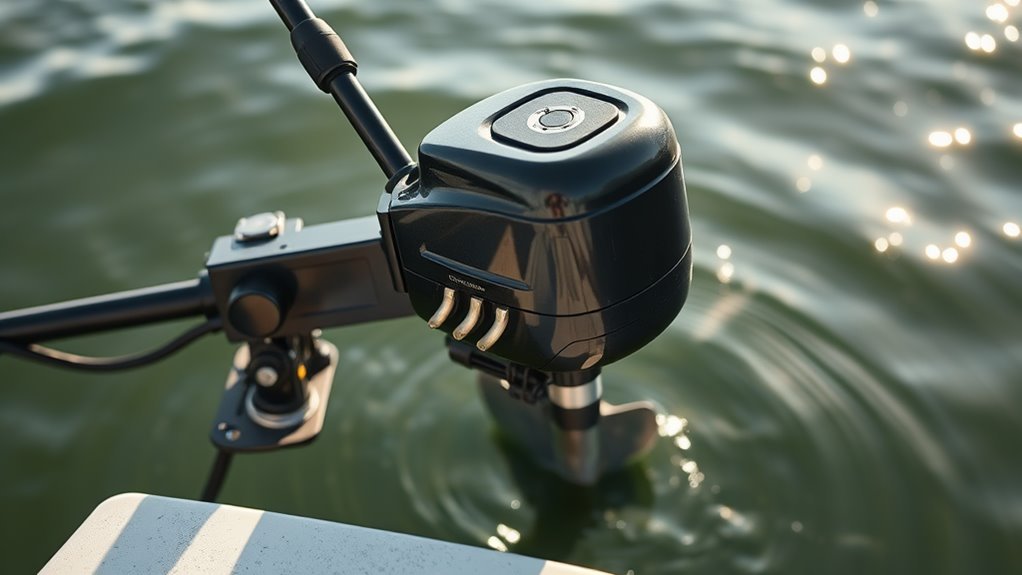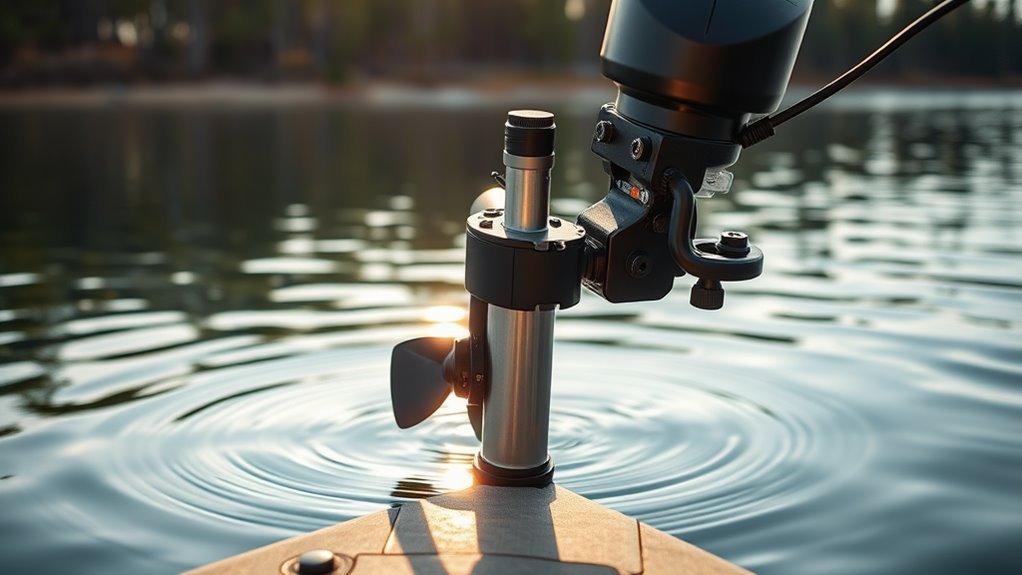A trolling motor turns a peaceful morning fishing trip into a controlled hunt for the perfect catch. As a boat mechanic who’s spent decades on the water, I can tell you these compact electric motors are simple but brilliant. They convert basic 12-volt battery power into smooth, precise movement through the water.
The beauty of these motors lies in their straightforward operation – they’re essentially an electric motor, propeller, and control system working together. The motor spins the prop, pushing water backward to move your boat forward. A control head lets you adjust speed and direction without making a sound that might spook the fish.
I’ve installed hundreds of these units over my career, and the technology keeps improving while the core function stays the same. The key components remain unchanged: a sealed electric motor unit, a sturdy shaft that houses the wiring, and a propeller designed for efficient thrust at low speeds.
Having this understanding helps anglers get the most from their equipment – whether you’re stalking bass in the shallows or maintaining position against current. It’s the difference between random drifting and purposeful fishing that puts more catches in the boat.
“A good trolling motor is like having an extra set of hands on your boat – it handles the positioning while you focus on fishing,” as I often tell my customers at the repair shop.
Essential Components of a Trolling Motor

When you’re looking to understand trolling motors, you’ve got to start with the core components that make these essential fishing tools work.
Electric trolling motors begin with a powerful electric motor – either brushed or brushless – that converts battery power into mechanical energy. The propeller, carefully designed for peak thrust, transforms this energy into forward motion to maneuver the boat.
A sturdy shaft connects these elements, while a mounting bracket secures everything to your vessel. You’ll find these brackets in various styles: bow, transom, or engine mounts – each serving specific needs.
The control system ties it all together, giving you command through tiller handles, foot pedals, or remote controls. It’s this combination of components working in harmony that makes electric trolling motors such efficient fishing companions. Additionally, understanding thrust requirements ensures that you select the right motor for your boat’s weight and fishing conditions.
Basic Operating Principles and Power Transfer
To harness the full power of a trolling motor, you’ve got to understand the elegant simplicity of its operation. Electric trolling motors are designed to convert battery power into thrust through a straightforward process. We’ll show you how this works.
| Power Stage | Action | Result |
|---|---|---|
| Battery | Electrical Energy | Powers Motor |
| Motor | Mechanical Energy | Spins Propeller |
| Propeller | Water Displacement | Creates Thrust |
The control mechanisms let you maneuver a boat with precision – think of it as power steering for your vessel. Through the foot pedal or tiller handle, we’re able to adjust speed and direction instantly. Remember, proper battery care is essential; without adequate power, even the best trolling motors won’t deliver the thrust you need for effective navigation. Additionally, understanding battery management is crucial for ensuring optimal performance during your adventures.
Different Types and Mounting Configurations

The primary decision you’ll face with trolling motors comes down to mounting location and control style.
We’re seeing most serious anglers opt for bow-mounted electric motors with foot pedal controls, while casual users often prefer transom-mounted options for their small boat simplicity.
Let’s break down the key mounting types and their benefits:
- Bow-mounted: Superior maneuverability, better drift control, and hands-free operation through foot pedals.
- Transom-mounted: Easy retrofitting, simple tiller steering, perfect for basic trolling needs.
- Engine-mounted: Specialized setup for larger vessels, combining primary and secondary propulsion.
Your choice affects everything from steering response to positioning control. Bow-mounted units excel in wind and current, while transom mounts shine in straightforward trolling scenarios. Think about your fishing style – it’ll guide your decision. Additionally, bow mounted motors provide superior control, leading to improved fishing success rates.
Safety and Maintenance Best Practices
Since your trolling motor’s longevity hangs on consistent upkeep, let’s explore the non-negotiable maintenance routine you’ll need.
We’re talking about a three-pronged approach here. First, inspect your electric motor and propeller after each use – scrub off that stubborn algae and check for wear.
Second, don’t skimp on battery care. Regular charging isn’t optional; it’s your insurance against getting stranded.
Third, keep safety equipment within arm’s reach – life jackets and emergency signals aren’t decorative items.
Smart boating means staying weather-aware and cutting power when conditions turn nasty. Regular inspection of cables and wires is crucial to ensure optimal performance and safety.
Trust us, your trolling motors will reward proper maintenance with years of reliable service.
Think of it as protecting your investment while ensuring every boating experience remains safe and enjoyable.
Selecting the Right Trolling Motor for Your Boat

Picking your ideal trolling motor isn’t a game of eeny-meeny-miny-mo. We need to match thrust ratings to your boat’s weight, calculating 2 pounds of thrust per 100 pounds of loaded vessel. Power needs vary dramatically based on your conditions and usage.
Let’s nail down your three critical selection factors:
- Mount type – bow-mounted for precise fishing control or transom-mounted for simpler operation
- Environment – saltwater demands corrosion resistance and longer shafts vs. standard freshwater motors
- Power configuration – from basic 30-pound thrust to 100+ pounds, matched with proper battery setup. Ensure you consider the thrust requirements based on your boat’s weight and additional load to avoid underpowering.
Modern GPS features and autopilot can transform your fishing game, but don’t get distracted by bells and whistles. Focus first on matching the motor’s core specs to your boat’s requirements.
Frequently Asked Questions
How Does a Trolling Motor Operate?
We’ll find trolling motors use electric power to spin propellers, with various types offering different steering mechanisms and speed controls. They’re mounted on boats and require regular maintenance for peak performance.
How Long Will the Battery Run on a Trolling Motor?
Time is money when managing battery runtime! We’ll typically get 3-10 hours depending on battery capacity, voltage requirements, and motor efficiency. Smart power management and proper battery maintenance guarantee ideal usage duration.
How Does a Trolling Motor Get Power?
We’ll typically power our trolling motors using 12V, 24V, or 36V deep cycle marine batteries. Regular charging maintains efficiency, while monitoring amp draw helps prevent battery drain and guarantees reliable performance.
How Big of a Boat Will a 55LB Trolling Motor Push?
We’ve found that a 55lb trolling motor can effectively push boats up to 2,750 pounds in calm conditions, making it ideal for small to medium fishing boats, though performance varies with weather and load.